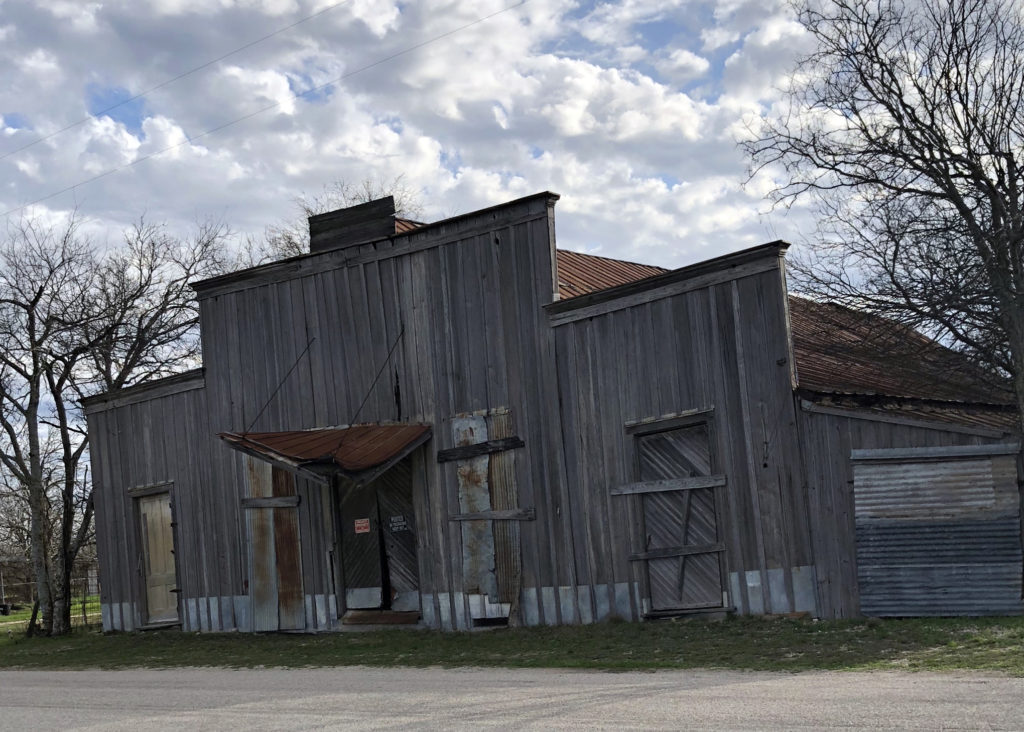
(Unless otherwise sited, references are from The History of Medina County Texas, Volumes I & II and txtransportationmuseum.org)
Stories of experiences in small towns that once were bustling communities but are now mere whispers of their pasts have much of their factual histories recorded in books and on the internet. But, as time moves on and generations pass, gone are the soon-to-be forgotten stories and anecdotes of these towns of our past. One such town is Dunlay, Texas.
It is said that the community of Dunlay boasted several previous names: Interprise, Harper, Summit, and Baldwin Station. When the Galveston, Harrisburg, and San Antonio Railroad arrived in the early 1880s, the final name change occurred, chosen after Jerry Dunlay, a G.H. & SA train conductor.
The first three businesses, built in 1883 and ’84, were the cotton gin, Carle General Store – later to become L.A. Haby General Store – and Brucks Lumberyard. Meanwhile, in late 1881, when the rails were being laid for the G.H. & SA Railroad, a Mr. and Mrs. August Reitzer came to Dunlay to manage the Harvey Eating House and to board section hands. The railroad had built a house for them, and they remained in the area for several years. One son, William, settled there permanently. The community continued to grow and soon had a saloon, a blacksmith shop, a molasses press, a train depot, a section foreman’s house and section hands’ houses, a loading dock – used in later years as a gathering place – shipping pens for cattle cars, a grain warehouse and scales (privately owned), a grist mill, a butcher shop, and a boarding house. In 1890, a post office was granted. Mr. Joe H. Steinle served as postmaster from 1908- 1956. By 1890s, the population had grown to forty. Other residents in the early days included the Krenmuellers, Habys, Breitens, Heligmans, Steiglers, Nesters, and Krienwalds….
In 1910, the first rural mail route was established. Mr. John Bohlen – some of whose descendents still live in the community – was the rural carrier. Traveling by horse and buggy in the beginning, his route included Quihi and the Bader Settlement – which was located some five miles west of Castroville. Around the same time, the first rural telephone was put into operation. Then, in 1913, the Hermann Sons Hall was erected.
In 1911, the railroad, whose main line crosses under Hwy 90 at Dunlay and runs along it on the north side, built a spur line from Dunlay to the Medina Dam building site. Dunlay subsequently played a major role in the construction of Medina Lake. “When Medina Lake was begun in 1911, temporary tracks were constructed to bring in laborers and supplies to the construction site. Two switchers were leased from the railroad to move the massive amounts of lumber and cement required for the project.” The Dunlay railroad also served as a means for people to visit the lake for swimming and picnicking, even after the lake was completed, as no roads had been built for some time.
The Dunlay School District #33 was established early, encompassing approximately twenty-five square miles of territory, with the first school house situated in the village of Dunlay. In 1917, the building was moved to sit one mile south of Highway 90. This move was made as most of the students came from the northern part of the district. In later years, the school house was moved to the intersection of 90 and CR 4643 and served as the Dunlay PO. Eventually, the post office was closed and the building reportedly was purchased by a private citizen and moved to the Frio River near Leakey.
By 1914, the population of Dunlay had reached 100 residents. In 1922, State Highway 3 was improved through Castroville, Dunlay, Hondo, and D’Hanis and later designated as U.S. Highway 90. By the 1960s, population had reached 150. But the population fell back down to the 100s after the post office closed in the mid 70s. (texasscapaes.com)
Few folks remain who can recall experiences of Dunlay during its hey-day, but soon-to-be 93-year-old Castroville resident Jack Wernette relates fond memories.

Jack recalls that most folks were related to his Uncle Louis (L.A.) Haby; Jack’s grandmother was L.A.’s younger sister.
There was also an Uncle Adolph and Aunt Rosa who lived on the other side of the railroad, in the house that is still occupied and stands right alongside the tracks. Jack tells of walking down the block to visit them on the dirt street.
There was another relation “down the dirt road” – Cousin Ed. Jack recalls playing with Ed’s son Erick Jerome (E.J.), while visiting relatives there. Jack, who grew up in Castroville, tells that in those days, vacations consisted of visiting relatives for days or weeks at a time, and he amusingly adds that the big excitement for the kids was when the train came through town and stopped at the water tank.
Another exciting experience was visiting Great Uncle Jacob and his wife, Maggie. They “talked Alsatian in those days,” and the first time Jack heard the coyotes howl, he didn’t know what it was, and his aunt got a kick out of telling others – in her native language – about the boy’s startled reaction!
Remember the rural telephone that was introduced to the community? Jack says that it was always fun when the phone rang on the “party line,” because everyone ran to the phone, picked it up, covered the mouth piece, and listened intently to hear what was being said and what was going on in the outside world!
Every aunt and uncle Jack visited had a piano in the front room, a room that was always closed off except for special occasions – that was the culture then. Jack had taken music lessons from the St. Louis School in Castroville, and he always enjoyed the opportunity to sit and play. And often, the pianos were “player pianos,” and it was a treat to pump it up and listen to music for entertainment!
As time moved on, the Depression of the 20s and 30s made a lasting impact on the community. L.A. Haby’s General Store, whose skeleton remains as an icon of the former Dunlay glory, had to close in the early 50s as a direct result of the Depression. According to L.A. Haby’s great grandson, Louis Haby, people began to trade land for goods, and eventually, with little cash exchanging hands, it became unfeasible for its owner to remain in business. As a result of those land trades, however, L.A. Haby had acquired some 1000 acres, running several miles south of Dunlay and west toward the Lower Elstone Road.
Eventually, the building which had served as a general store to the Dunlay and surrounding communities – Hondo resident J.D. Schmidt says he well remembers going there to shop for supplies with his mother as a child – was sold to the Nester family, who had moved into the area in the late 40s. They used it for repairing old equipment for their construction business. A daughter, Beverly Nester Keller, recalls as a child going into the old building and seeing relics of its former glory: old shelves used in the pharmacy and old wood stoves stored in the basement where the Nesters worked on equipment.
Another victim of the Depression, the railroad, which had become the Southern Pacific, had had to close many of their stations, and that included the one in Dunlay. Today, none of the businesses remain, and only a few of the original homes do. Fortunately, much of its history is recorded for future descendants and curious newer residents to appreciate.